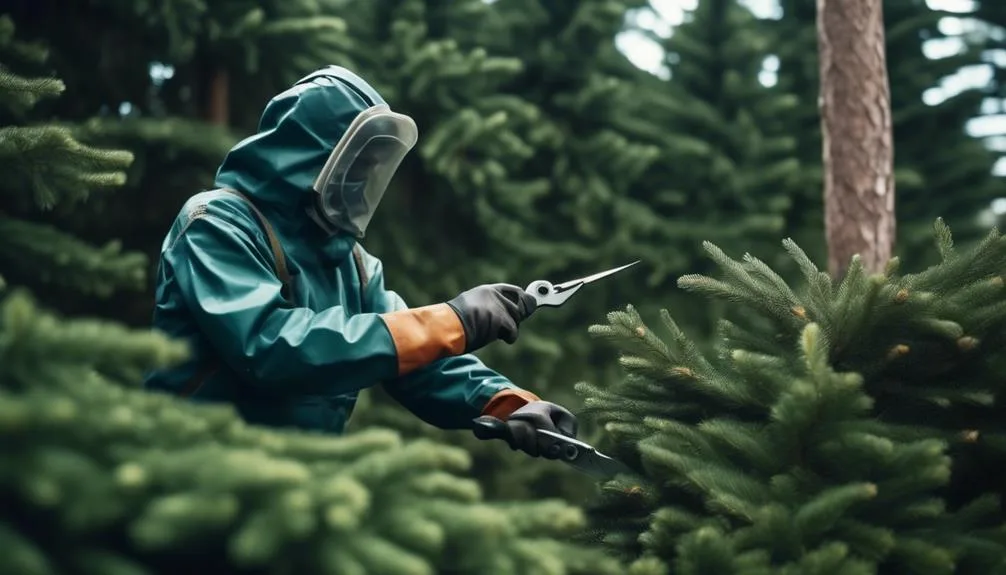Pruning a spruce tree might seem like a big job, but with the right knowledge and techniques, it can be a satisfying way to keep your tree healthy and looking good. As a spruce tree owner, it's important to understand when and how to prune to help your tree thrive.
Having the right tools and knowing the proper techniques are key. So, how do you go about pruning your spruce tree to make sure it stays healthy and strong?
Understanding the Pruning Needs of Spruce Trees
Understanding the pruning needs of spruce trees is essential for maintaining their health and promoting optimal growth. Pruning frequency is key to ensuring that your spruce trees remain healthy and vibrant. Regular pruning helps maintain an ideal branch structure, allowing for better air circulation and sunlight exposure throughout the tree.
Aim to prune your spruce trees annually during the dormant season, typically in late winter or early spring. This timing helps minimize stress on the tree and reduces the risk of disease or pest infestation. When pruning, focus on removing any dead, damaged, or diseased branches, as well as any crossing or crowded branches.
This will help improve the overall health and appearance of your spruce trees, contributing to their long-term vitality.
Identifying the Right Time to Prune
To ensure the health and vitality of your spruce trees, it's crucial to determine the optimal timing for pruning. Pruning at the right time is essential for promoting tree health and encouraging healthy tree growth. Here is a table to help you identify the best time to prune your spruce trees:
| Season | Best Time to Prune |
|---|---|
| Spring | After new growth has emerged |
| Summer | Early summer, once new growth has slowed down |
| Fall | Late fall, after growth has stopped for the season |
Pruning during the recommended seasons will help maintain the overall health and appearance of your spruce trees. It's important to remember that improper timing can potentially harm the tree and disrupt its growth pattern.
Essential Tools for Pruning Spruce Trees
When it comes to pruning spruce trees, having the right tools is essential for ensuring a successful and effective pruning process.
Essential pruning equipment for spruce trees includes:
- Sharp bypass pruners for cutting small branches
- Loppers for thicker branches
- A pruning saw for larger limbs
Ensure that your tools are clean and well-maintained to make precise cuts that promote the tree's health.
Additionally, it's crucial to prioritize safety precautions when using pruning equipment.
- Wear protective gear such as gloves, safety goggles, and a hard hat to shield yourself from any falling debris.
- Always use a sturdy ladder or platform to reach higher branches safely.
Proper Techniques for Pruning Spruce Trees
To properly prune spruce trees, it's important to understand the correct techniques for promoting healthy growth and maintaining the tree's natural shape. When pruning spruce trees, it's essential to consider the pruning benefits. Proper pruning encourages new growth, improves air circulation, and enhances the overall health of the tree.
Start by removing any dead, damaged, or diseased branches to prevent the spread of infection. Additionally, focus on maintaining the tree's natural branch structure to support its overall strength and aesthetics. Avoid cutting off large sections of healthy greenery, as this can hinder the tree's ability to photosynthesize and thrive.
Always use sharp, clean tools to make precise cuts and minimize stress on the tree. By following these proper techniques, you can help your spruce tree flourish and remain beautiful for years to come.
Maintenance Tips for Healthy Spruce Trees
Start by incorporating the proper pruning techniques discussed earlier to maintain the health and vigor of your spruce trees. In addition to proper pruning, regular maintenance is essential for healthy spruce trees. Consider the following maintenance tips to ensure the well-being of your trees:
| Maintenance Tips for Healthy Spruce Trees |
|---|
| Pruning Frequency |
| Regularly inspect and prune as needed to remove dead or diseased branches. |
| Seasonal Considerations |
| Conduct major pruning during late winter or early spring, and minor pruning can be done in late spring or early summer. |
| Watering and Mulching |
| Ensure adequate watering, especially during dry periods, and apply a layer of mulch around the base of the tree. |
| Fertilization |
| Apply a balanced fertilizer in early spring to support healthy growth. |
| Pest and Disease Control |
| Monitor for pests and diseases, and take appropriate measures for control. |
Conclusion
Ensure the long-term health and beauty of your spruce trees by using the right tools and techniques for maintenance. Regular care and attention will keep them thriving for years to come.
Happy pruning!

My interest in trees started when I first saw the giant sequoias in Yosemite.
I was a teenager then, and I remember thinking, “I need to learn more about this.”
That moment stuck with me.
A few years later, I went on to study forestry at Michigan Tech.
Since graduating, I’ve worked in a mix of hands-on tree care and community education.
I’ve spent over ten years helping people understand how to plant, maintain, and protect the trees in their neighborhoods.
I don’t see trees as just part of the landscape.
They are living things that make a real difference in our daily lives.
